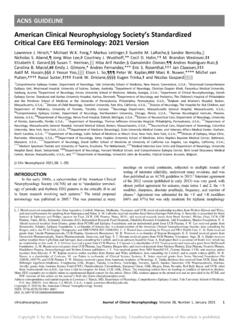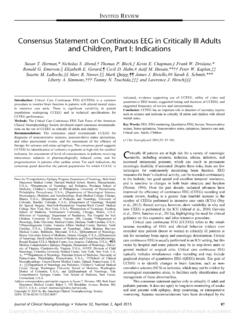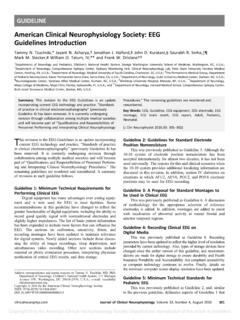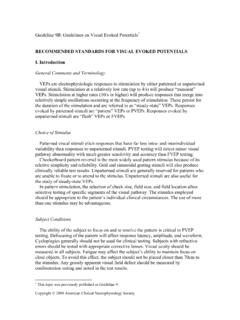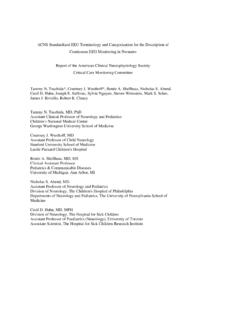Transcription of American Clinical Neurophysiology Society Guideline 3: A ...
1 Copyright 2016 American Clinical Neurophysiology Society 1 American Clinical Neurophysiology Society Guideline 3: A Proposal for Standard Montages to Be Used in Clinical EEG Jayant N Acharya, Abeer Hani, Partha Thirumala, Tammy N Tsuchida Introduction Montages are logical and orderly arrangements of channels (electrode pairs, with waveforms representing the potential difference between the two electrodes) that display EEG activity over the entire scalp, allow comparison of activity on the two sides of the brain (lateralization) and aid in localization of recorded activity to a specific brain region.
2 With 21 electrode positions in the 10-20 system and 16 channels, the number of possible montages is 2116. The 10-10 system, with more than 70 electrode positions, and the ability to display up to 256 channels in modern digital EEG machines, provides the ability to create an even greater number of montages. However, from a Clinical and practical standpoint, only a limited number of montages need to be used during a recording session. A great diversity of montages exists among different EEG laboratories, but many of these montages fail to display the EEG adequately or are inordinately complex.
3 Moreover, this diversity impedes interchange of information among electroencephalographers, to the ultimate detriment of patient care. Recognizing the need for improving this aspect of EEG practice, the montages listed in this Guideline are recommended for standard use by Clinical laboratories. This proposal should not be construed as an attempt to limit the total number of montages used by any EEG laboratory. Indeed, depending on individual recording circumstances, additional montages may be necessary for an adequate EEG examination and for the solution of particular problems.
4 The proposed montages are intended to constitute a basic minimum, not a maximum, for general-purpose use. If these recommendations are adopted widely, communication among electroencephalographers should be facilitated. Montages using additional electrode positions described in the 10-10 system are particularly useful during video-EEG monitoring, especially in patients with suspected temporal or frontal lobe epilepsy , but can also be helpful for routine EEG recording. This Guideline provides some suggested montages for use in these situations.
5 However, the proposed montages are not designed for other special purposes, such as for neonatal EEGs, all-night sleep recordings, or for verification of electrocerebral inactivity. 1. Montage Designations The class of montage is designated as follows: longitudinal bipolar (LB), transverse bipolar(TB), or referential (R). (Bipolar derivations are also sometimes called differential .) The numeral to the left of the point indicates the number of channels. Montages are designed for 16, 18, and 20 channels. The numeral 2 or 3 to the right of the point indicates an alternative montage of the same Copyright 2016 American Clinical Neurophysiology Society 2 class for a particular size of instrument ( , and are alternative for ).
6 The number of alternatives has been limited to a maximum of three. 2. Recommendations Governing Selection of the Proposed Montages with Explanatory Notes The Committee reaffirms the statements pertaining to montages set forth previously in the Guidelines of the American Clinical Neurophysiology Society (ACNS) and that are paraphrased as follows: (a) that no less than 16 channels of simultaneous recording be used, and that a larger number of channels be encouraged, (b) that the full 21 electrode placements of the 10-20 System be used, (c) that both bipolar and referential montages be used for Clinical interpretation, (d) that the electrode derivations of each channel be clearly identified at the beginning of each montage, (e) that the pattern of electrode connections be made as simple as possible and that montages should be easily comprehended, (f)
7 That the electrode pairs (bipolar) preferentially should run in straight (unbroken) lines and the inter-electrode distances kept equal, (g) that tracings from the more anterior electrodes be placed above those from the more posterior electrodes on the recording page, and (h) that it is very desirable to have some of the montages comparable for all EEG laboratories. The Committee recommends a left above right order of derivations, , on the recording page left-sided leads should be placed above right-sided leads for either alternating pairs of derivations or blocks of derivations.
8 This recommendation coincides with the prevailing practice of the vast majority of EEG laboratories, at least in North America and in many other areas. A maximum number of electrodes should be represented in each montage, within limitations imposed by the number of recording channels, to ensure adequate coverage of head areas. Three classes of montage should be represented in each recording: LB, TB, and R. For 16- and 18-channel recording, one montage from each of the three classes will be needed (see Table 1).
9 If 20 channels are available, 2 channels of polygraphic variables may be added to the 18-channel bipolar montages, and a reference to Cz in between those to Fz and Pz. TABLE 1: Number of montages recommended _____ Number of Channels Longitudinal bipolar Transverse bipolar Referential Total 20 1 (3) 1 (2) 1 (3) 3 Copyright 2016 American Clinical Neurophysiology Society 3 18 1 (3) 1 (2) 1 (3) 3 16 1 (3) 1 (3) 1 (3) 3 (Figures in parentheses refer to the number of alternative montages proposed.)
10 For adequate mapping of electrical fields, additional montages may need to be devised that include LB and TB chains recorded simultaneously. In the montages listed for R recording, leads on the mandibular angles may be substituted for the leads on the earlobes if the change is duly noted. Potential pitfalls in referential recording are numerous, and caution should be exercised if unwanted activity appears in a reference lead. In such instances, another reference should be chosen and the change should be clearly noted in the recording.
